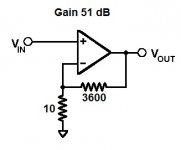Opamps are generally happy to operate at high closed loop gains, but remember that the useful bandwidth will be ~divided by the closed loop gain.
With your example, if you select a part having 1MHz GBW product, your final bandwidth will be ~1000/360=2.77KHz. Not very nice for audio.
On the other hand, an uncompensated NE5534 will give you ~55KHz: acceptable
With your example, if you select a part having 1MHz GBW product, your final bandwidth will be ~1000/360=2.77KHz. Not very nice for audio.
On the other hand, an uncompensated NE5534 will give you ~55KHz: acceptable
Hi,
Typically the needed gain for MM-pickups falls close to +40db(@1kHz) and around +60db for MC-pickups. While +40dB of gain hardly presents a problem for a good lownoise OP-Amp, +51dB is already ambitious and +60dB is close to impossible. I´d rather opt for two gain stages in the last case, mybe even the second case.
Because of the falling response of the openloop gain the amount of feedback left for correction action sinks with rising frequency. Fortunately the RIAA equalizing curve shows a similarly falling response. Apart from the small step between 500Hz and 2120Hz the response follows the openloop response of an Op-Amp in parallel. This fact keeps the feedback factor nearly constant over frequency. Just take a look at a OP-amps datasheet and see how much feedback is left at 1kHz and the desired gain.
If e.g. a AD797 features an OL-gain of ~100dB @1kHz (see p.8, Fig. 16 of datasheet) app. 50dB of feedback would be left at a gain of +51dB. This leaves roughly 46dB of feedback left at higher frequencies >2120Hz and app 55dB at frequencies <500Hz. This should be enough feedback to keep distortions low and the precision of the equalizing curvature high.
The voltage- and current-noise figures are sufficiently low with this Op-Amp and its capable to supply for comparatively high output currents to drive rather low-impedance (lownoise) feedback networks. The LM49990 appears to be similarly well suited for this application.
jauu
Calvin
Typically the needed gain for MM-pickups falls close to +40db(@1kHz) and around +60db for MC-pickups. While +40dB of gain hardly presents a problem for a good lownoise OP-Amp, +51dB is already ambitious and +60dB is close to impossible. I´d rather opt for two gain stages in the last case, mybe even the second case.
Because of the falling response of the openloop gain the amount of feedback left for correction action sinks with rising frequency. Fortunately the RIAA equalizing curve shows a similarly falling response. Apart from the small step between 500Hz and 2120Hz the response follows the openloop response of an Op-Amp in parallel. This fact keeps the feedback factor nearly constant over frequency. Just take a look at a OP-amps datasheet and see how much feedback is left at 1kHz and the desired gain.
If e.g. a AD797 features an OL-gain of ~100dB @1kHz (see p.8, Fig. 16 of datasheet) app. 50dB of feedback would be left at a gain of +51dB. This leaves roughly 46dB of feedback left at higher frequencies >2120Hz and app 55dB at frequencies <500Hz. This should be enough feedback to keep distortions low and the precision of the equalizing curvature high.
The voltage- and current-noise figures are sufficiently low with this Op-Amp and its capable to supply for comparatively high output currents to drive rather low-impedance (lownoise) feedback networks. The LM49990 appears to be similarly well suited for this application.
jauu
Calvin
- Status
- This old topic is closed. If you want to reopen this topic, contact a moderator using the "Report Post" button.
